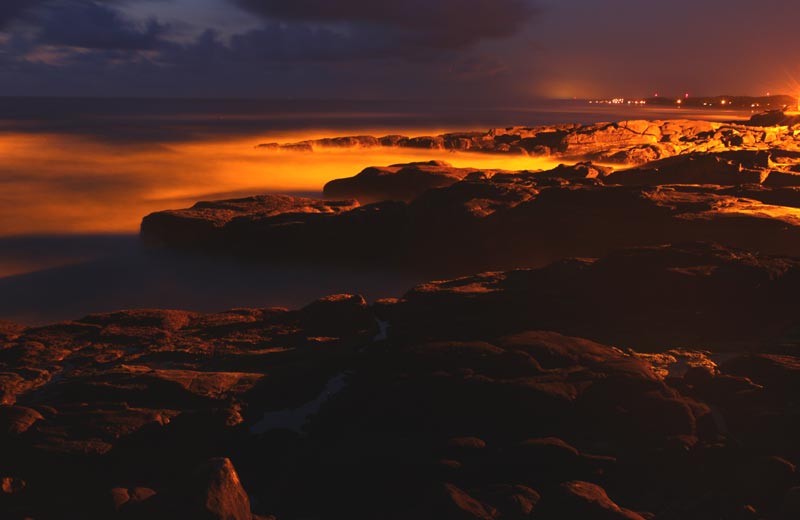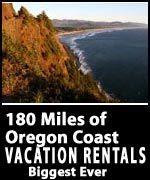Spooky Lava Rivers Created Much of N. Oregon Coast
Published 03/29/21 at 6:05 PM PDT
By Oregon Coast Beach Connection staff
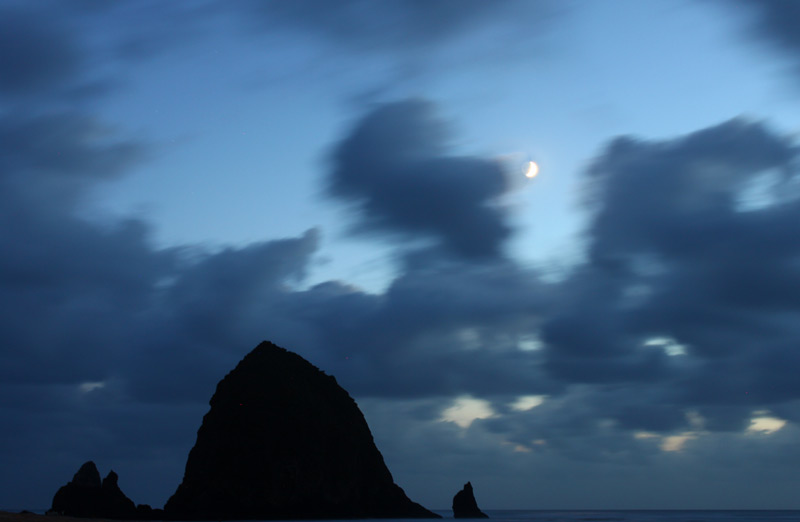
(Oregon Coast) – It’s about as apocalyptic a scene as any movie could conjure up. (Above: Cannon Beach's Haystack Rock was created by these lava flows in a weird, weird way)
Picture this: a massive river of lava comes searing its way westward from Idaho, so huge it covers miles at a time yet going only four mph. Along the way, entire forests become ashes and fumes. The lava build gigantic damns – or deltas – that were miles long, sometimes bulging up to 20 feet high. It bubbles its way through riverbeds, canyons and over hills, mostly meandering around mountains, until it slithers its sinister, scorching heat into the ocean – some 300 miles - about seven days later. It’s hundreds of miles long, spewing out continuously and fiercely so that when it reaches the ocean it fills crevices and muddy areas thousands of feet deep.
Includes exclusive listings; some specials in winter
In Cannon Beach:
Includes rentals not listed anywhere else
In Manzanita, Wheeler, Rockaway Beach:
Some specials for winter
In Pacific City, Oceanside:
Some specials for winter
In Lincoln City:
Some specials for winter
In Depoe Bay, Gleneden Beach:
Some specials for winter
In Newport:
Look for some specials
In Waldport
Some specials for winter
In Yachats, Florence
Some specials for winter
Southern Oregon Coast Hotels / Lodgings
Reedsport to Brookings, places to stay; winter deals
This was what Oregon and the Oregon coast looked like 12 to 18 million years ago – possibly hundreds of times. Back then, the coastline was about 20 miles inland still and none of it resembled what it looks like now.
A colossal fissure in the Earth around Lewiston, Idaho, poured these horrendous flows into this area. It’s the same weak spot in the Earth’s crust that now powers Yellowstone National Park (the continental plate has moved in those millions of years), and it has before created the mega-disastrous super volcanoes that have erupted a few times over various millennia. Sometimes these lava flows poured into the ocean, spread out through the soft marine sediments for dozens of miles, and then managed to re-erupt through thousands of feet of muck, onto the sea floor, essentially making their own eruptions for a brief time (geologically speaking).
All this is just basic geology about the Oregon coast, affirmed decades ago and still talked about by now-famous geologist names such as Seaside’s Tom Horning, PSU’s Scott Burns or Eugene’s Marli Miller.
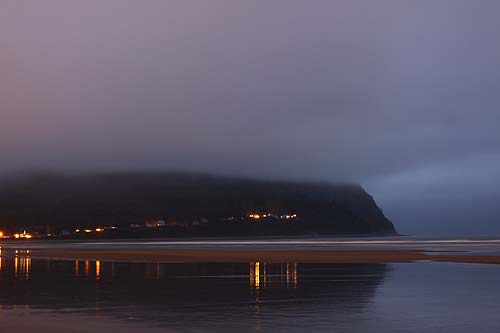
Seaside / Tillamook Rock: all this once a canyon filled with lava, then the rest eroded away leaving this
All these lava flows reached as far south on the Oregon coast as Newport, maybe occasionally around Yachats. Yachats is its own bag of geological tricks, clocking in at more around 30 million years old. The southern Oregon coast – including Brookings, Gold Beach, Bandon’s Face Rock or the multivarious shapes of Coos Bay – is easily 50 million years old or more and the result of dozens of different things.
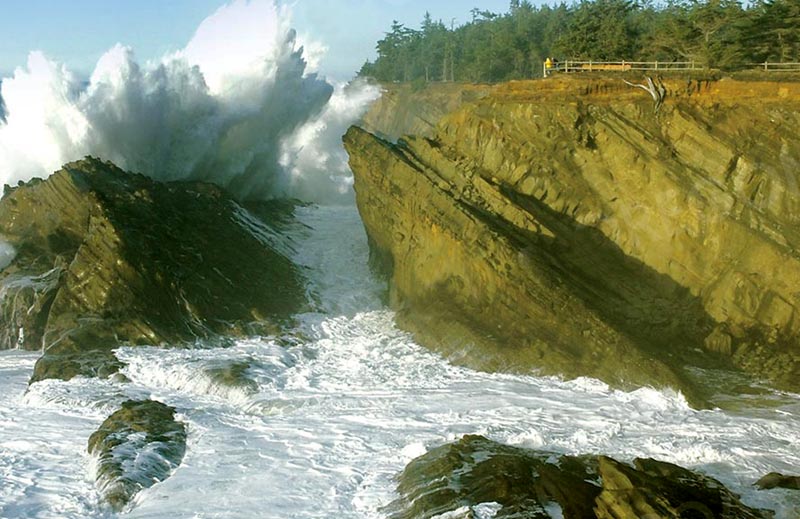
Coos Bay / Shore Acres - courtesy Oregon's Adventure Coast
However, up north, you’ll recognize these remnants of scary lava flows in the form of Yaquina Head, Cape Foulweather, Cape Meares, Tillamook Head and Neahkahnie Mountain. Even offshore wonders that everyone loves like Three Arch Rocks, Rockaway Beach’s Twin Rocks and Cannon Beach’s Haystack Rock were the result of this – and there’s a twist their stories.
Over millions of years, some of these massive invasions of lava (solid basalt) were lifted with the sediments above sea level with the rising of the coast range. They in turn were eroded away, until they formed headlands and features we now know as Neahkahnie Mountain near Manzanita or Tillamook Head between Seaside and Cannon Beach.
Another kind of lava flow that formed the headlands we know and love is called intra-canyon flows. These snaked their way to the coast through riverbeds and around other features, arriving at the coast to build up and up out of deltas of rubbly submarine pillow basalt, which were capped by sheets of dry-land lava flows.
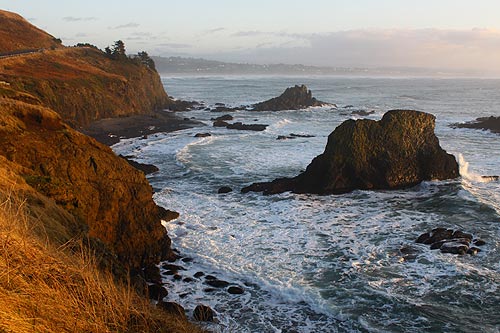
Yaquina Head
They too were eroded by time and water into shapes we now know as Cape Foulweather, Cape Lookout, Yaquina Head and Cape Meares.
Numerous such lava flows (perhaps around 300) erupted from about 12 million years ago to 17 million years ago, according to Seaside resident and geologist Tom Horning. They happened approximately every 100,000 to 200,000 years, creating their own kind of havoc, but in turn laying the groundwork (pun intended) for the beauty we now see.
Meanwhile, millions of years earlier, Cascade Head was its own volcano, said Horning. And what about those mini-eruptions that happened just offshore? Horning said they’re often responsible for many of the coast’s most famous landmarks.
“Haystack Rock in Cannon Beach was one of those,” Horning said. “Sea stacks are often from submarine feeders for the re-erupting lavas. They’re all part of plumbing systems.”
Erosion also plays a major part in what you see with the famous structure along with the oceans rising, falling and the land doing the same.
“The basalt that Haystack Rock is made of is about 15 million years old,” Horning said. “It was an enormous hill of rock until about 3000 years ago, when rising sea levels allowed the surf to wash away all but the strongest lava/basalt. Some 4000 to 5000 feet of the original submarine volcano is missing from it now, having been eroded for more than 12 millions years.
Oregon Coast Hotels in this area - South Coast Hotels - Where to eat - Maps - Virtual Tours
Cannon Beach Lodging
Nehalem Bay Lodgings
Manzanita Hotels, Lodging
Three Capes Lodging
Pacific City Hotels, Lodging
Lincoln City Lodging
Depoe Bay Lodging
Newport Lodging
Waldport Lodging
Yachats Lodging
Oregon Coast Vacation Rentals
Oregon Coast Lodging Specials
Yachats at night: lighting temperatures cause this lava-like look. It could be a bit like what the coast looked like during these lava flows
More About Oregon Coast hotels, lodging.....
More About Oregon Coast Restaurants, Dining.....
LATEST Related Oregon Coast Articles
A curious weather phenomenon that happens more out here
Curb, Road Construction Resumes in Lincoln City as Oregon Coast Season Begins...
Crews return Sept 15 with some dust and small delays. Traffi
NASA Announces First Evidence of Life on Mars in Possible Biosignature
In a former riverbed billions of years old, they found spots with interesting compounds. Astronomy
Portland, Oregon - Beaverton, Oregon Weather and Alerts | Current Conditions,...
Current weather conditions and alerts for Portland and Beaverton
Oregon Coast Scenic Railroad's Fame Engine Turns 100 Years Old with Special Runs
Sept 20 and 21 various special rides. Garibaldi events, Rockaway Beach events, Wheeler events
South Oregon Coast Goes Interstellar: Coos Bay's Sunset Bay Astronomy Fest Se...
Shore Acres State Park gets spacey. Coos Bay events
Swarm of 12 Quakes Fire Off 100 Miles from South Oregon Coast
After the initial 5.8, ranging in magnitude from 2.7 to 5.1: Coos Bay, Port Orford, Bandon, Gold Beach. Geology, weather
SOLVE Cleanup Happens Along Oregon Coast, Inland Sept 20 Through 28
SOLVE is inviting volunteers to take part. Brookings events, Gold Beach events, Port Orford events, Coos Bay events, Bandon events, Florence events, Yachats events, Newport events, Lincoln City events, Rockaway Beach events, Manzanita events, Cannon Beach events, Seaside events, Astoria events
Back to Oregon Coast
Contact Advertise on BeachConnection.net
All Content, unless otherwise attributed, copyright BeachConnection.net Unauthorized use or publication is not permitted
Keywords: Oregon Coast, Geology, science, Cape Meares, Yachats, beaches, Coos Bay, Tillamook Rock, Haystack Rock, Seaside, Astoria, Cannon Beach, Manzanita, Rockaway Beach, Newport, Bandon, Pacific City, Lincoln City, Depoe Bay


























